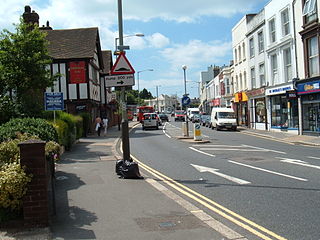
Ore is a large suburb of the urban area of Hastings, in the Hastings district, in the county of East Sussex, England. Formerly a village, it is still known and advertised locally as "Ore Village". It is located 1.3 miles (2.1 km) to the north-east of Hastings town centre, on the main A259 road to Rye. Its name may have originated from the Old English word for "stream-bank". The Ore Stream still runs through a large central Woodland area known locally as Speckled Wood at the top of the Valley. It is the largest suburb of Hastings.

St Lawrence is a village and former civil parish, now in the parish of Ventnor, on the south coast of the Isle of Wight, in southern England. It is located to the west of the town of Ventnor, in the Undercliff, which is subject to landslips. The Undercliff lies between the original high cliff and the sea, formed over thousands of years, since the last Ice Age, from accumulated landslips. Several rocky coves can be accessed from the coastal path, which affords fine views of some prominent Victorian villas, set in a wooded landscape below the great rock wall of the original sea cliff: Woody Bay, Mount Bay and Orchard Bay. The area of the parish was around 329 acres (133 ha) in size. In 1931 the parish had a population of 329. On 1 April 1933 the parish was abolished and merged with Ventnor.

Mottistone is a village and former civil parish, now in the parish of Brighstone, on the Isle of Wight, England. It is located in the popular tourist area the Back of the Wight. It is located 8 miles southwest of Newport in the southwest of the island, and is home to the National Trust's Mottistone Manor. In 1931 the parish had a population of 114. On 1 April 1933 the parish was abolished and merged with Brighstone.

Thorley is a village and former civil parish, now in the parish of Yarmouth, on the Isle of Wight, England. It is 1+1⁄2 miles (2.4 km) from Yarmouth in the northwest of the island and is 9 miles (14 km) west from Newport. In 1931 the parish had a population of 125.

Thurgarton is a village and former civil parish, now in the parish of Aldborough and Thurgarton, in the North Norfolk district of the county of Norfolk, England. It lies 6½ miles north of Aylsham and 5½ miles south-west of Cromer, and was once part of the North Erpingham hundred. In 1931 the parish had a population of 186.
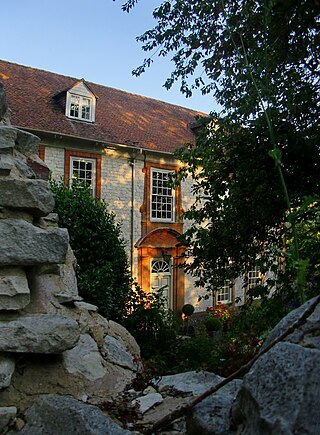
Treyford is a hamlet, Anglican parish and former civil parish, now in the civil parish of Elsted and Treyford, in the Chichester district of West Sussex, England. The hamlet sits on the Elsted to Bepton Road 4 miles (6.4 km) southwest of Midhurst. In 1931 the civil parish had a population of 104.
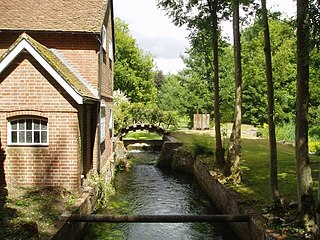
Itchen Abbas is a village and former civil parish, now in the parish of Itchen Valley, in the Winchester district, in the county of Hampshire, England. The village is on the River Itchen about 4 miles (6.4 km) north-east of Winchester.
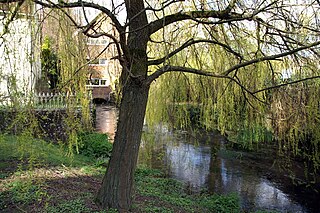
Corhampton is a village and former civil parish, now in the parish of Corhampton and Meonstoke, in the Winchester district, in the county of Hampshire, England. It lies on the western bank of the River Meon. In 1931 the parish had a population of 87. On 1 April 1932 the parish was abolished and merged with Meonstoke to form "Corhampton and Meonstoke".

Yaverland is a village and former civil parish, now in the parish of Sandown, on the Isle of Wight, England. It is just north of Sandown on Sandown Bay. It has about 200 houses. About 1⁄3 of a mile away from the village is the Yaverland Manor and Church. Holotype fossils have been discovered here of Yaverlandia and a pterosaur, Caulkicephalus. The White Air extreme sports festival was held annually at Yaverland pay and display car park between 1997 and 2008, but moved to Brighton for 2009.

Little Mongeham is a small hamlet and former civil parish, now in the parish of Sutton, in the Dover district, in Kent, southeast England, near Dover. The main buildings are Little Mongeham House and Manor Farm. Little Mongeham was until the early twentieth century a parish in its own right, including Studdal and Maidensole, and with its own rector, though the church has long since been in ruins, the foundations can still be found just to the southwest of the double bend in Willow Road through the village. The scholar Richard James held the living of Little Mongeham from 1629. In 1931 the parish had a population of 265. On 1 April 1935 the parish was abolished and merged with Sutton.

Elmstone is a village and former civil parish, now in the parish of Preston, in the Dover district, in East Kent, England. It is situated between Canterbury and Sandwich. The Domesday Book of 1086 records Elmstone as 'Aelvetone'. In 1086 the recorded population was 3 households. In 1931 the parish had a population of 117. On 1 April 1935 the parish was abolished and merged with Preston, part also went to Wingham.
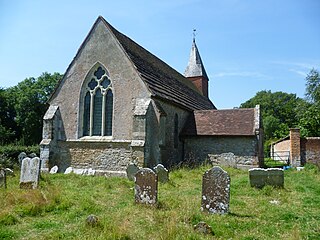
Warminghurst is a village and former civil parish, now in the parish of Thakeham, in the Horsham district of West Sussex, England. It lies on the Ashington to Heath Common road 2.4 miles (3.9 km) northeast of Storrington. In 1931 the parish had a population of 93. On 1 April 1933 the parish was abolished and merged with Ashington.

Knotting is a village and former civil parish, now in the parish of Knotting and Souldrop, in the Bedford district, in the ceremonial county of Bedfordshire, located near the border with Northamptonshire. Nearby places are, Sharnbrook, Podington, Odell, Melchbourne, Yelden, Newton Bromswold, Souldrop and Rushden over the border in Northamptonshire. In 1931 the parish had a population of 114. On 1 April 1934 the parish was abolished to form "Knotting and Souldrop".
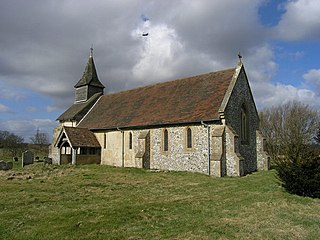
Colemore is a village and former civil parish, now in the parish of Colemore and Priors Dean, in the East Hampshire district, in the county of Hampshire, England. It is in the Hampshire Downs about 5 miles (8 km) northwest of Petersfield. In 1931 the parish had a population of 72. On 1 April 1932 the parish was abolished and merged with Priors Dean to form "Colemore and Priors Dean".

Empshott is a village and former civil parish, now in the parish of Hawkley, in the East Hampshire district of Hampshire, England. It lies 3.5 miles (5.5 km) southwest of Bordon, its nearest town. The nearest railway station is 2.7 miles (4.4 km) southeast of the village, at Liss. In 1931 the parish had a population of 171.
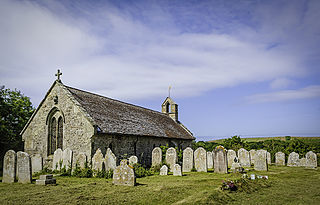
St James' Church, Kingston is a parish church in the Church of England located in Kingston, Isle of Wight. Formerly a separate Anglican parish, Kingston is now amalgamated with the adjacent Anglican parish of Shorwell, as Shorwell with Kingston.

Shelton is a village and former civil parish, now in the parish of Dean and Shelton, in the Bedford district, in the ceremonial county of Bedfordshire, England. In 1931 the parish had a population of 101. On 1 April 1934 the parish was abolished and merged with Dean to form "Dean and Shelton".

Morestead is a village and former civil parish, now in the parish of Owslebury, in the Winchester district, in Hampshire, England. It is in the South Downs, about 3 miles (5 km) southeast of Winchester. In 1931 the parish had a population of 96. On 1 April 1932 the parish was abolished and merged with Owslebury.

Gratwich is a village and former civil parish, now in the parish of Kingstone, in the East Staffordshire district, in the county of Staffordshire, England. It is miles southwest of Uttoxeter in the valley of the River Blythe. In 1931 the parish had a population of 58.

Newport and Carisbrooke, formerly just Newport is a civil parish on the Isle of Wight, in the county of the Isle of Wight, England. The parish includes the settlements of Newport, Carisbrooke, Apesdown, Barton, Bowcombe, Clatterford, Cross Lane, Fairlee, Forest Side, Gunville, Hunny Hill, Pan, Parkhurst, Rowridge, Shide and Staplers. In 2011 the parish had a population of 25,496. The parish touches Arreton, Brighstone, Calbourne, Newtown and Porchfield, Chillerton and Gatcombe, Havenstreet and Ashey, Northwood, Shorwell, Whippingham and Wootton Bridge. There are 338 listed buildings in Newport and Carisbrooke. The community council is based in The Granary in Newport.





















